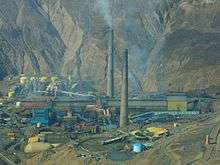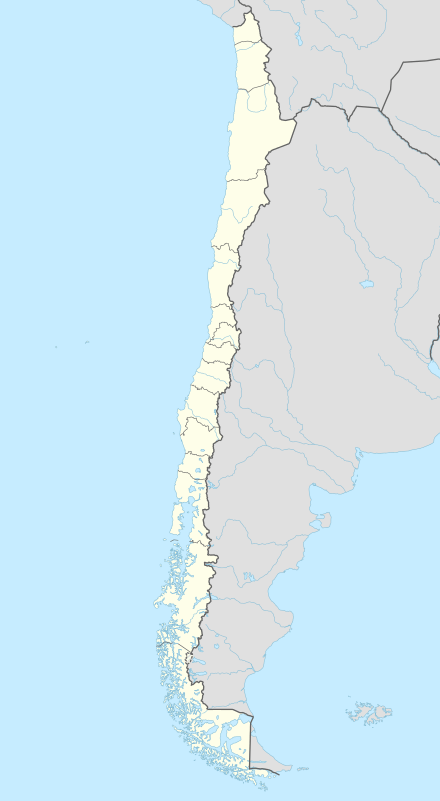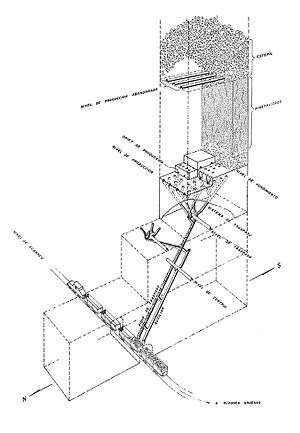El Teniente
 Copper smelter at El Teniente | |
| Location | |
|---|---|
 El Teniente | |
| Location | Sewell |
| Province | Cachopoal |
| Country | Chile |
| Coordinates | 34°05′16″S 70°23′15″W / 34.08778°S 70.38750°WCoordinates: 34°05′16″S 70°23′15″W / 34.08778°S 70.38750°W |
| Production | |
| Products | Copper |
| Type | Underground |
| History | |
| Opened | 1819 |
| Owner | |
| Company | Codelco |

El Teniente ("The Lieutenant") is an underground copper mine in the Chilean commune of Machalí in Cachapoal Province, Libertador General Bernardo O'Higgins Region, near the town of Sewell, 2,300 m (7,500 ft) above mean sea level in the Andes.
Mining at El Teniente is reported to have started as early as 1819. Kennecott Copper Corporation ran the mine through a subsidiary company up until the Chilean nationalization of copper and the formation of the state owned copper mining company Codelco, who currently operates the mine. With over 3,000 kilometres (1,900 mi) of underground drifts,[2] it is reported as "the world's biggest underground copper mine",[3][4] and is the largest of Codelco's operations.[5]
El Teniente mine is undergoing, since 2011, a structural project called New Mine Level (NML). It consists of expanding the mine deeper into the hill at 1,880 meters above sea level. The project is being carried out without interrupting the operation of El Teniente Division.[6]
History
According to legend, the El Teniente mine was discovered in the 1800s by a fugitive Spaniard official, with exploitation beginning in 1819. The best ore was mined manually in what would be called the Fortuna sector, and transported by animal.
In 1904 William Braden (an engineer from New York City)[7] and E.W. Nash formed the Braden Copper Company, built a road for carts, and a concentrating plant, which was in operation by 1906.[8][9] In June 1910, the Guggenheims took control of the mine and provided financing.[9]:146-147
Chileans referred to the large scale mining operation as La Gran Minería del Cobre.
In 1967 the Chilean government bought a 51% stake in the mine and founded Sociedad Minera El Teniente. Under this agreement a new concentrator was built, and the mine expanded its production to 63,000 t (69,000 short tons) per day.[8] Braden became a subsidiary company of Kennecott Copper Corporation[10] in 1916 and on July 11, 1971 with the Chilean nationalization of copper under President Salvador Allende[11] and the formation of the Corporación Nacional del Cobre de Chile (known as Codelco), El Teniente became a state owned operation. The Chilean government was to pay Kennecott $92.9-million for the property.[12] The mine has increased production to 100,000 t (110,000 short tons) of ore per day,[8] and in 2006 the mine produced over 418,000 t (461,000 short tons) of copper.[13]
The Vancouver, Canada based company Amerigo produces both a copper and molybdenum concentrate from El Teniente's tailings, and also has the right to treat higher grade tailings from a large abandoned tailings impoundment near to the El Teniente property.[14]
Geology
The copper ore deposits are those of a typical copper porphyry and associated alteration-mineralization. These altered zones include chalcopyrite, pyrite, bornite and molybdenite as hypogene minerals and chalcocite as a supergene mineral.[15] The ore body surrounds the Braden Pipe in a continuous ring with a width of 2000 feet. The pipe is a geologic structure in the shape of an inverted cone, having a surface diameter of 4000 feet, and consisting of post-pipe breccia called the Braden Formation. The boundary of the pipe is marked by this post-pipe breccia and a pre-pipe breccia forming a belt up to 200 feet wide. "The Braden Pipe was a center of strong mineralization and structural weakness before the pipe was formed." Copper mineralization and pipe formation occurred in the Pliocene. Ore was originally mined from the Fortuna orebody at the southwest quadrant starting in 1906. Since 1922, the larger Teniente orebody has also been mined on the east side. "The best grade of ore is found in altered andesite or in andesitic flow breccia adjacent to the pre-pipe breccia."[16]
Labour disruptions
As of 2007 Codelco employed 17,000 direct-hire company employees and 28,000 contract employees across all their operations.[17] There have been multiple labour disruptions at the El Teniente mine.
1983
In 1983 El Teniente and two other Codelco mines closed when approximately 13,000 workers voted to strike "indefinitely" in protest of a union leaders arrest for calling for an end to military rule in Chile. Between the three mines at least 3,300 workers and 37 labour leaders were fired for participating in the strike.[18]
2008
Contract workers went on strike at Codelco mines in 2008. El Teniente and two other Codelco mines were closed, El Teniente for the shortest length. Company employees continued to work, however striking workers closed access to the mines and threw stones at buses transporting employees from the mine to the town of Rancagua. At least one employee was injured, he was hit by a metal object thrown by a protester on the highway leading to the mine.[19]
See also
- Escondida
- Chanarcillo
- Los Pelambres mine
- Potrerillos, Chile
- Chuquicamata
- El Salvador mine
- Mining in Chile
References
| Wikimedia Commons has media related to El Teniente. |
- ↑ Lindgren, Waldemar; Bastin, Edson (1922). "The geology of the Braden Mine, Rancagua, Chile". Economic Geology. XVII (2): 99.
- ↑ Jamasmie, Cecilia. "This is what the world's largest underground mine looks like". Mining.com. Retrieved 11 March 2015.
- ↑ "Codelco says electrical fire dented Teniente output". Reuters. April 9, 2009. Retrieved 2009-04-10.
- ↑ "Chile's copper industry: Reviving Codelco". The Economist. 2010-10-21. Retrieved 2010-10-22.
- ↑ Craze, Matthew (April 21, 2008). "Codelco Says 3 of 4 Copper Mines Shut After Attack (Update2)". Bloomberg. Retrieved 2009-04-10.
- ↑ "New Mine Level Project". Digiscend.com. 2014. Retrieved 2015-03-07.
- ↑ Fox Przeworski, Joanne (1978). The decline of the copper industry in Chile and the entrance of North American Capital. Ayer Publishing. p. 25. ISBN 978-0-405-13379-4. Retrieved 2009-04-10.
- 1 2 3 W. A. Hustrulid, Richard C. Bullock (ed.). "51". Underground Mining Methods. Society of Mining Engineering. p. 417. ISBN 978-0-87335-193-5. Retrieved 2009-04-10.
- 1 2 Charles Caldwell Hawley (2014). A Kennecott Story. The University of Utah Press. p. 104-105.
- ↑ "CHILE ACQUIRES 51% OF EL TENIENTE MINE". The New York Times. April 14, 1967. pp. Business & Finance 59. Retrieved 2009-04-10.
- ↑ Craze, Matthew (April 11, 2007). "Copper Passion Drives Trader on Quest for Antiques (Update1)". Bloomberg. Retrieved 2009-04-10.
- ↑ Gerd, Wilcke (January 4, 1972). "KENNECOTT SEEKS PAYMENT BY CHILE; Asks Government to Honor Installment on Note KENNECOTT SEEKS PAYMENT BY CHILE". The New York Times. Retrieved 2009-04-10.
- ↑ "Ficha técnica División El Teniente". Codelco.com. Retrieved 2010-10-22.
- ↑ Hill, Liezel (27 March 2009). "Amerigo will generate own power to cut Chile costs". Creamer Media's Mining Weekly.
- ↑ Camus, Francisco (1975). "Geology of the El Teniente orebody with emphasis on wall-rock alteration". Economic Geology. 70 (8): 1341–1372. doi:10.2113/gsecongeo.70.8.1341.
- ↑ Howell, Fred; Molloy, John (1960). "Geology of the Braden orebody, Chile, South America". Economic Geology. 55 (5): 863–905. doi:10.2113/gsecongeo.55.5.863.
- ↑ Estrada, aniela (31 July 2007). "Chile: Copper Miners Protest Subcontracting Practices". Inter Press Service.
- ↑ "Army Takes Over 2 Mines as Workers Strike in Chile". Philadelphia Inquirer. June 19, 1983. pp. A07. Retrieved 2009-04-10.
- ↑ Matthew, Craze; Sebastian Boyd (April 23, 2008). "Codelco, Striking Workers May End Dispute Soon (Update1)". Bloomberg. Retrieved 2009-04-10.